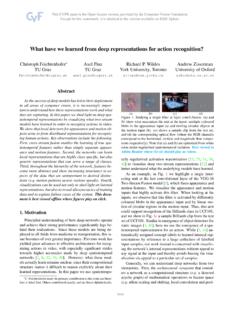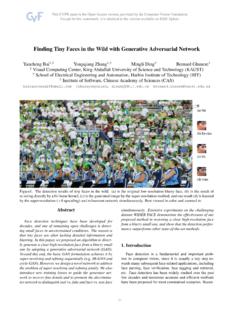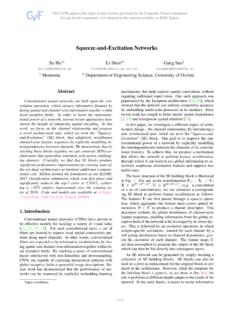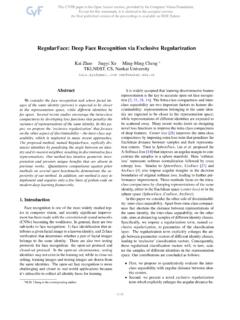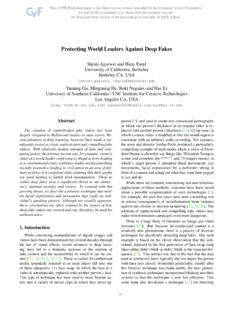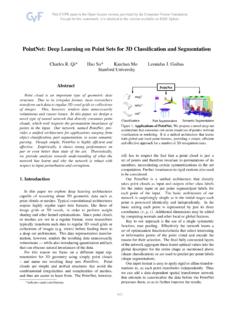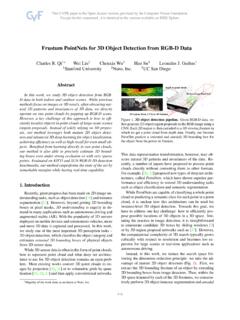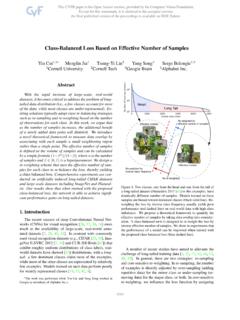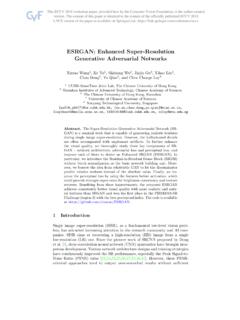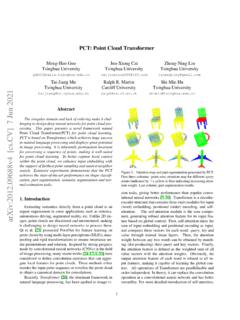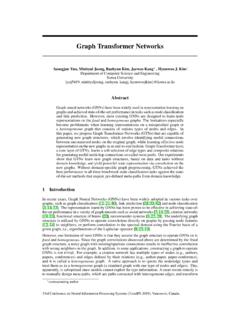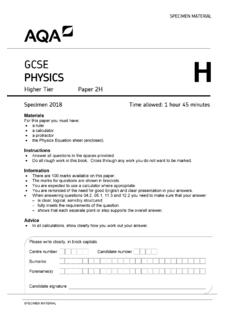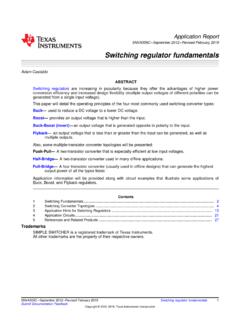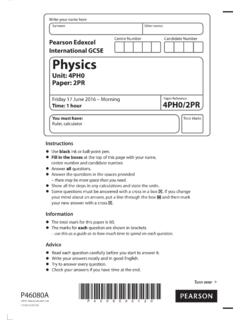Transcription of Transformer Interpretability Beyond Attention Visualization
1 Transformer Interpretability Beyond Attention VisualizationHila Chefer1 Shir Gur1 Lior Wolf1,21 The School of Computer Science, Tel Aviv University2 Facebook AI Research (FAIR)AbstractSelf- Attention techniques, and specifically transformers ,are dominating the field of text processing and are becom-ing increasingly popular in computer vision classificationtasks. In order to visualize the parts of the image thatled to a certain classification, existing methods either relyon the obtained Attention maps or employ heuristic prop-agation along the Attention graph.
2 In this work, we pro-pose a novel way to compute relevancy for Transformernetworks. The method assigns local relevance based onthe Deep Taylor Decomposition principle and then prop-agates these relevancy scores through the layers. Thispropagation involves Attention layers and skip connections,which challenge existing methods. Our solution is basedon a specific formulation that is shown to maintain the to-tal relevancy across layers. We benchmark our methodon very recent visual Transformer networks, as well ason a text classification problem, and demonstrate a clearadvantage over the existing explainability methods.
3 Ourcode is available at: IntroductionTransformers and derived methods [41,9,22,30] arecurrently the state-of-the-art methods in almost all NLPbenchmarks. The power of these methods has led to theiradoption in the field of language and vision [23,40,38].More recently, transformers have become a leading toolin traditional computer vision tasks, such as object detec-tion [4] and image recognition [6,11]. The importance ofTransformer networks necessitates tools for the visualiza-tion of their decision process. Such a Visualization can aidin debugging the models, help verify that the models are fairand unbiased, and enable downstream main building block of Transformer networks areself- Attention layers [29,7], which assign a pairwise atten-tion value between every two tokens.
4 In NLP, a token istypically a word or a word part. In vision, each token canbe associated with a patch [11,4]. A common practice whentrying to visualize Transformer models is, therefore, to con-sider these attentions as a relevancy score [41,43,4]. This isusually done for a single Attention layer. Another option isto combine multiple layers. Simply averaging the attentionsobtained for each token, would lead to blurring of the sig-nal and would not consider the different roles of the layers:deeper layers are more semantic, but each token accumu-lates additional context each time self- Attention is rollout method [1] is an alternative, which reassigns allattention scores by considering the pairwise attentions andassuming that attentions are combined linearly into subse-quent contexts.
5 The method seems to improve results overthe utilization of a single Attention layer. However, as weshow, by relying on simplistic assumptions, irrelevant to-kens often become this work, we follow the line of work that assigns rel-evancy and propagates it, such that the sum of relevancyis maintained throughout the layers [27]. While the ap-plication of such methods to transformers has been at-tempted [42], this was done in a partial way that does notpropagate Attention throughout all networks heavily rely on skip connectionand Attention operators, both involving the mixing of twoactivation maps, and each leading to unique , transformers apply non-linearities other thanReLU, which result in both positive and negative of the non-positive values, skip connections lead,if not carefully handled, to numerical instabilities.
6 Meth-ods such as LRP [3] for example, tend to fail in such layers form a challenge since a naive propa-gation through these would not maintain the total amount handle these challenges by first introducing a rele-vancy propagation rule that is applicable to both positiveand negative attributions. Second, we present a normal-ization term for non-parametric layers, such as add ( ) and matrix multiplication. Third, we in-tegrate the Attention and the relevancy scores, and combinethe integrated results for multiple Attention of the Interpretability methods used in computervision are not class-specific in practice, , return the same782visualization regardless of the class one tries to visualize,even for images that contain multiple objects.
7 The class-specific signal, especially for methods that propagate all theway to the input, is often blurred by the salient regions ofthe image. Some methods avoid this by not propagating tothe lower layers [32], while other methods contrast differ-ent classes to emphasize the differences [15]. Our methodprovides the class-based separation by design and it is theonly Transformer Visualization method, as far as we can as-certain, that presents this , Interpretability , and relevance are not uni-formly defined in the literature [26].
8 For example, it is notclear if one would expect the resulting image to containall of the pixels of the identified object, which would leadto better downstream tasks [21] and for favorable humanimpressions, or to identify the sparse image locations thatcause the predicted label to dominate. While some meth-ods offer a clear theoretical framework [24], these rely onspecific assumptions and often do not lead to better perfor-mance on real data. Our approach is a mechanistic oneand avoids controversial issues. Our goal is to improvethe performance on the acceptable benchmarks of the goal is achieved on a diverse and complementary setof computer vision benchmarks, representing multiple ap-proaches to benchmarks include image segmentation on a sub-set of the ImageNet dataset, as well as positive and negativeperturbations on the ImageNet validation set.
9 In NLP, weconsider a public NLP explainability benchmark [10]. Inthis benchmark, the task is to identify the excerpt that wasmarked by humans as leading to a Related WorkExplainability in computer visionMany methods weresuggested for generating a heatmap that indicates local rel-evancy, given an input image and a CNN. Most of thesemethods belong to one of two classes: gradient methodsand attribution basedmethods are based on the gradients withrespect to the input of each layer, as computed throughbackpropagation. The gradient is often multiplied by the in-put activations, which was first done in the Gradient*Inputmethod [34].
10 Integrated Gradients [39] also compute themultiplication of the inputs with their derivatives. However,this computation is done on the average gradient and a lin-ear interpolation of the input. SmoothGrad [36], visualizesthe mean gradients of the input, and performs smoothing byadding to the input image a random Gaussian noise at eachiteration. The FullGrad method [37] offers a more com-plete modeling of the gradient by also considering the gra-dient with respect to the bias term, and not just with respectto the input. We observe that these methods are all class-agnostic: at least in practice, similar outputs are obtained,regardless of the class used to compute the gradient that isbeing GradCAM method [32] is a class-specific approach,which combines both the input features and the gradientsof a network s layer.
